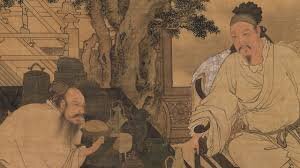What ancient expression of identity hides behind the mysterious layers of old Chinese art?
Old Chinese art is not merely a collection of decorative pieces or ceremonial works. It is a visual journey through time, belief, and identity—a deeply rooted cultural treasure that silently narrates the philosophical, spiritual, and historical experiences of one of the world’s oldest civilizations. From ancient bronzes to silent ink scrolls, old Chinese art unveils a rich canvas of dynastic transformation, regional influences, and an enduring dialogue between nature and humanity.
The Foundations of Old Chinese Art
The roots of old Chinese art reach back to the Neolithic period, where symbolic jade carvings and painted pottery were crafted not just for aesthetics but for cultural significance. As early as 5000 BCE, Chinese artisans were shaping items that reflected ritual practices, cosmological ideas, and social status. These creations evolved as Chinese dynasties rose and fell, but the underlying principles of harmony, balance, and symbolism remained intact.
By the time of the Shang (1600–1046 BCE) and Zhou (1046–256 BCE) dynasties, Chinese bronze casting had reached astonishing levels of complexity. Ritual vessels known as ding, gui, and zun were adorned with taotie masks, abstract animal motifs meant to represent spiritual guardians or mystical forces. These objects were not simply tools for rituals; they embodied a cosmological map of the world, reflecting beliefs in ancestors, nature, and the heavens.
Philosophical Influence and Aesthetic Depth
What sets old Chinese art apart is its integration of philosophy into visual expression. Daoism, Confucianism, and Buddhism—three major streams of thought—intertwined with artistic creation. The Daoist ideal of wu wei (non-action) and harmony with nature influenced the simplicity and fluidity seen in landscape paintings and ink wash techniques. Confucian values such as hierarchy, loyalty, and righteousness found expression in formal portraiture and historical illustrations.
Meanwhile, Buddhist influence introduced new dimensions. After Buddhism spread into China during the Han Dynasty (206 BCE–220 CE), its spiritual imagery evolved within local traditions, giving rise to massive cave temple carvings, such as those in Dunhuang and Longmen. These masterpieces fused foreign religious iconography with native styles, offering a unique lens through which one can trace the spiritual diversity of ancient China.
Scrolls, Brushes, and Stories on Silk
One of the most celebrated mediums in old Chinese art is the handscroll and hanging scroll—long strips of silk or paper designed to be viewed section by section. These scrolls served not just as paintings but as narratives. Viewers were meant to “travel” through the painting, gradually uncovering the story.
Renowned artists like Gu Kaizhi of the Eastern Jin Dynasty and Fan Kuan of the Song Dynasty introduced new techniques that highlighted not just form but inner expression. Gu Kaizhi’s “Admonitions of the Instructress to the Court Ladies” uses brush lines with poetic rhythm, portraying moral instruction and social refinement. Fan Kuan’s “Travelers Among Mountains and Streams” immerses the observer in vast natural scenes, suggesting the insignificance of humans before nature’s grandeur—an idea deeply tied to Daoist thinking.
Symbolism and Identity
Old Chinese art is heavily symbolic. Every element—from the stroke of a bamboo leaf to the positioning of a dragon—carries meaning. For instance, plum blossoms symbolize perseverance and renewal, while cranes represent longevity. Artists did not merely paint for beauty; they embedded messages about life, virtue, seasons, and the cosmos.
Even the choice of materials held symbolic value. Jade, for instance, was regarded as the “stone of heaven.” It was carved with care and often buried with the deceased as a link to the afterlife. Calligraphy, another central component, was not seen as writing but as a visual art that revealed the personality and cultivation of the artist. The script itself was a meditative act—a path to self-discipline and spiritual alignment.
Dynastic Evolution in Old Chinese Art
Each dynasty in Chinese history left a distinct imprint on its artistic tradition. During the Tang Dynasty (618–907 CE), cosmopolitan openness allowed old Chinese art to absorb Central Asian influences, evident in tomb figurines and Buddhist iconography. The Song Dynasty (960–1279 CE) emphasized lyrical landscape painting and refined brushwork, while the Yuan Dynasty (1271–1368 CE), under Mongol rule, witnessed a shift toward more individualistic and expressive art, often created by scholar-artists outside the official court.
The Ming (1368–1644) and Qing (1644–1912) dynasties revived classical forms but introduced vibrant colors and increased technical sophistication. Porcelain reached its zenith, and imperial patronage supported monumental projects and elaborate works that blended artistic mastery with political power.
Old Chinese Art Today
Today, the fascination with old Chinese art continues to grow globally. Museums in Beijing, Taipei, London, and New York house priceless pieces that scholars and enthusiasts flock to study. Collectors seek early ceramics, ink scrolls, jade carvings, and bronze vessels—each a timeless relic of Chinese cultural memory.
Modern Chinese artists often reflect on old Chinese art, reviving brush techniques, calligraphy, and symbolism in contemporary formats. Galleries, educational institutions, and international exhibitions now regularly feature these age-old treasures, sparking new appreciation and awareness.
China’s own cultural preservation efforts, including digital archiving and restoration of ancient works, ensure that old Chinese art remains not just a relic of the past, but an enduring testament to the nation’s identity.
Final Thoughts
Old Chinese art is more than a window into a vanished era—it is a mirror reflecting the eternal truths and shifting ideals of Chinese civilization. It invites viewers to engage not only with artistic beauty but with cultural wisdom, philosophical insight, and the evolution of human expression. Through layers of ink, bronze, jade, and silk, old Chinese art tells stories that still resonate today, making it an unbreakable thread that binds the past to the present. Whether you’re a historian, collector, or someone discovering it for the first time, the world of old Chinese art offers an unforgettable journey into the heart of China’s cultural soul.

